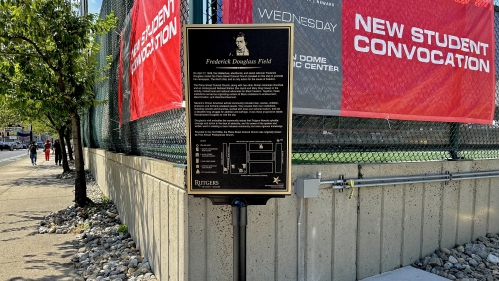The naming of Frederick Douglass Field at Rutgers-Newark is complete now that a plaque marks the spot where Douglass gave a speech to 19th-century Black activists at the Plane Street Colored Church in 1849.
It was installed on the corner of University Avenue and Warren Street, where the church used to stand, a location declared a historic site last year by the National Park Service for its links to the Underground Railroad. It is one of the first sites in Northern New Jersey to receive that designation.
The field was named in honor of Douglass in 2019. A former slave, he escaped to freedom and became one of the most significant leaders in American history. The plaque describes him as an “intellectual, abolitionist and social reformer,’’ who visited the church to promote his newspaper, The North Star and rally African American abolitionists in Newark.
The plaque is not only a celebration of Douglass but honors a community of local freedom fighters.
"Newark’s African American activist community included men, women, children, enslaved and formerly enslaved people,’’ the plaque reads. “They created their own institutions, including schools and churches, worked with local and national leaders, and led the decades-long struggle for abolition and suffrage. It was these progressive ideals that attracted Douglass to the city.’’
Additional sites in the area, and a map of where they stood, are also marked on the plaque, including two additional African American churches and an Underground Railroad Station, known as the Jacob and Mary King house.
Rutgers-Newark Chancellor Nancy Cantor, who suggested the field’s new name based on student and faculty research at RU-N, praised the installation of the plaque.
"This marker will serve as a permanent reminder of the deep resonance between Frederick Douglass’ lifelong work and Rutgers-Newark’s reason for being. It takes broad coalitions to make real change. That is what Frederick Douglass was about and that is what Rutgers-Newark is about,’’ said Cantor.
She added, “To make sustainable change, we need to continually cultivate new generations of change-makers to follow in the footsteps of courageous visionaries like Frederick Douglass. At Rutgers-Newark, we continually recommit ourselves to join with partners across our community to cultivate the change-makers in our midst. That is not just a good thing, but an essential thing for realizing the full potential of our diverse democracy.”
Instrumental to the site’s recognition is Noelle Lorraine Williams, a historian and 2020 alumna of the M.A in American Studies program, who wrote and researched the park service application, which detailed the role of the Plane Street Church as a hub of the abolitionist movement.
Williams, who is also an artist, learned of the church’s history while researching her multimedia project, Black Power! 19th Century, which focused on the efforts of Black Newarkers to organize against oppression since before the Revolutionary War. She wrote and researched the application, submitted by the university, at the suggestion of Kenneth B. Morris, the great-great-great grandson of Douglass.
The church building closed in 1905, after it fell into disrepair and the congregation moved. It once stood on a block that was part of Newark’s Black community until the city condemned buildings there. From 1959 to 1967, redlining and a practice known as “slum clearance,’’ moved 12,000 African American families from Newark’s downtown core. In 1967, Malcolm Talbott, provost of Rutgers-Newark, pushed to rename Plane Street as University Avenue.


